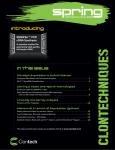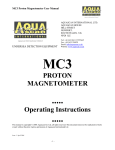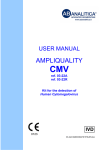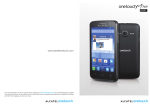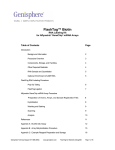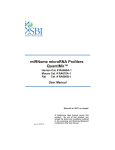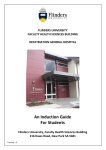Download Global MicroRNA Amplification Kit
Transcript
Global MicroRNA Amplification Kit Cat. # RA400A-1 User Manual Store kit at -20°C on receipt (ver. 3-060901) A limited-use label license covers this product. By use of this product, you accept the terms and conditions outlined in the Licensing and Warranty Statement contained in this user manual. Global MicroRNA Amplification Kit Cat. # RA400A-1 Contents I. Introduction and Background A. B. C. D. E. F. G. Overview MicroRNA and Other Small RNAs Small RNA Amplification Overview of Protocol List of Components Additional Required Materials Procedural Guidelines 2 2 3 6 7 7 8 II. Protocol A. Starting RNA B. Adaptor Ligation C. First-Strand cDNA Synthesis D. Second-Strand cDNA Synthesis and Amplification E. Gene-Specific Amplification Using Amplified cDNA F. Generation of Amplified Sense RNA by T7 IVT 9 9 10 11 12 13 III. Troubleshooting A. No Product from cDNA Amplification B. No Product with Gene-Specific Primers 14 14 IV. Appendix A. Related Products B. Technical Support 15 15 V. Licensing and Warranty Statement 888-266-5066 (Toll Free) 650-968-2200 (outside US) 16 Page 1 System Biosciences (SBI) User Manual I. Introduction and Background A. Overview This manual provides details and information necessary to use the Global MicroRNA Amplification Kit to uniformly and reproducibly amplify limited amounts of non-degraded as well as degraded RNA to provide sufficient template for quantitative PCR of selected small RNA gene transcripts. To ensure optimal results, please read the entire manual before using the reagents and material supplied with this kit. B. MicroRNA and Other Small RNAs The study of noncoding RNAs, especially noncoding micro RNAs (miRNA), has gained increasing attention in recent years. Micro RNAs are 19-24 nucleotide long single stranded RNAs that regulate the expression of target genes by interacting with complementary sites in the 3’ UTR of the target mRNAs and inhibiting translation. MiRNAs are a conserved group of noncoding RNAs with very important regulatory roles. Mature miRNAs are excised from stem-loop precursors, which are themselves transcribed as part of longer primary transcripts. These primary miRNAs appear to be processed by the RNAse Drosha in the nucleus, and the precursor miRNAs are exported to the cytoplasm where they are further processed by an RNAse Dicer. These enzymes are known to be important for the generation of mature small inhibitory RNAs of exogenously transferred small inhibitory RNA precursors. Determining the level of miRNAs has recently become a significant step in the progression of revealing the role miRNAs play in cellular development and disease. SBI has developed a simple and reliable method for preamplification of small RNAs for either qRT-PCR or miRNA microarray studies. There are estimated to be hundreds of distinct miRNAs in mammalian cells, not including the many other small noncoding RNAs. Because it is clear that a specific miRNA can influence the gene expression level of multiple genes, it is important to define the cell and tissue specificity, as well as the spatial and temporal expression pattern of miRNAs. However, the detection of miRNA expression has been met with significant difficulties, mostly due to their small size and low abundance. Originally, levels of miRNA were examined by Northern blot assays. However, this requires very large amounts of RNA, typically 10 – 15 μg. Recently, the highly sensitive method of real time quantitative PCR Page 2 ver. 3-060901 www.systembio.com Global MicroRNA Amplification Kit Cat. # RA400A-1 and highly scalable gene expression microarrays, often used to study the expression patterns of conventional mRNAs, have been applied to the study of miRNAs. These two techniques have advantages and disadvantages. Real time qPCR is highly sensitive, but has low throughput, and miRNA microarray studies have lower sensitivity, but are highly scalable. Since there are probably ≥ 500 distinct miRNAs, miRNA microarrays provide an effective primary screening method. However, miRNA microarrays require a large amount of starting total RNA, with several publications having described the use of ≥ 10µg of total RNA. For the study of low abundant miRNAs by microarrays, it can be necessary to size select for low molecular weight RNAs before labeling. The need for microgram amounts of RNA places severe restrictions on the types of tissue that can be studied, thus excluding clinical tissues such as FFPE or small biopsies or RNA obtained from laser capture microdissection in which yields of RNA can be in the low nanogram range. C. Small RNA Amplification The current method for amplifying miRNA involves many steps, and can take several days to complete. The method requires size selection of small RNA, two ligation steps—each requiring gel electrophoresis and RNA extraction steps—an RT step, followed by PCR amplification. SBI’s small RNA amplification system includes 3 steps which can be completed in less than 4 hours: (1) Ligation of an adaptor to the 3’-end of the RNA. Our use of a chimeric DNA/RNA adaptor and unique cocktail of enzymes and reaction conditions ensures efficient ligation. (2) Reverse transcription of the RNA and attachment of a 5’-end adaptor in the same reaction by template switching. (3) PCR amplification of the cDNA with a PCR polymerase mixture that incorporates a proof reading function. This ensures a high degree of sequence accuracy. The amplified cDNA is ready for qRT-PCR studies with no purification necessary. If desired, the amplified cDNA can be cloned by standard protocols for DNA sequence analysis. For miRNA microarray studies, the amplified 888-266-5066 (Toll Free) 650-968-2200 (outside US) Page 3 System Biosciences (SBI) User Manual cDNA is first purified on spin column and labeled via T7 in vitro transcription in the presence of fluorescently labeled nucleotides. The size of the amplified cDNA can be adjusted by the amount of time the reverse transcription is conducted. Shorter reaction times will enrich for smaller RNA amplification. Under conditions suggested in the user manual (5 minute RT reaction), the size range of ≤ 500nt RNA is efficiently amplified. The size distribution and banding pattern of amplified cDNA is shown in Figure 1 below. M amplified cDNA bp 500 400 200 region of mature microRNA 100 50 (together with adaptor) Fig. 1. Size distribution of amplified cDNA using the Global MicroRNA Amplification Kit. In this study, 50 ng of a pool of RNAs from 4 different tissues was amplified with the SBI kit and a small portion examined by gel electrophoresis. A banding pattern was observed which is consistent with amplification of several highly abundant small RNAs, as indicated. Because of the very small size and heterogeneity of microRNAs (19-24 nucleotides), and low abundance, it is not possible to observe the microRNA. However, as shown in Figure 2, the presence of microRNA is clearly visible. The yield of amplified cDNA is sufficient for several hundred quantitative PCR experiments or several microRNA microarray experiments. Note that the sizes of the microRNA amplified species (including the 60 nt adaptors) would range from 79 to 84 nts. Page 4 ver. 3-060901 www.systembio.com Global MicroRNA Amplification Kit Cat. # RA400A-1 An example of the representation of small noncoding RNAs following RNA amplification by RT-PCR is shown in Figure 2 below. 16 1 124a 142-3p 30-9-5p 22 let7a 148b 150 181a 5S U6 microRNAs Fig. 2. High representation of small RNAs after amplification. Small RNA was amplified from 50 ng of a pool of RNAs from 4 different tissues with the Global MicroRNA Amplification kit. The amplified cDNA was then tested for the presence of 12 small RNAs, including 10 specific miRNAs, by RTPCR. The number of PCR cycles was adjusted to provide similar amounts of PCR products. Differences in cycle number between the different small RNAs were as high as 6 cycles. For any method of gene transcript amplification method, it is important that the relative levels of RNAs be maintained during the amplification process. A quantitation comparison of the levels of small RNA before and after amplification is shown in Fig 3. 1000 900 Non-amplified Amplified band intensity 800 700 600 500 400 300 200 1 124a 142-3p 22 let7a 148b 150 U6 5s 0 181a 100 Fig. 3. Maintenance of relative expression levels of RNA amplified using the Global MicroRNA Amplification kit. In this experiment, 50 ng of a pool of RNAs from 4 different tissues was amplified and tested for the presence of 10 different noncoding small RNA by RT-PCR. The same RNA pool was tested and quantitated for the same small noncoding RNA before amplification. Care was taken to avoid the plateau phase of the PCR amplification. For all 10 small RNAs, the relative levels were maintained before and after amplification. 888-266-5066 (Toll Free) 650-968-2200 (outside US) Page 5 System Biosciences (SBI) User Manual D. Overview of Protocol 5‘ 3‘ 5‘ OH P 3‘ NH2 P Ligation, 1 hr. 5‘ P 3‘ T7 5‘ 3‘ 3‘ RT and adaptor attachment, 4 min. 5‘ 3‘ 5‘ melt / destroy RNA 10 min., 95°C 5‘ 3‘ PCR, 1 hr. T7 3‘ 3‘ 5‘ 5‘ T7 10 sec PCR extension time 3‘ 5‘ 5‘ 3‘ biotinylated primer OR T7 IVT with labeled nucleotides amplified M cDNA 5‘ 5‘ 5‘ 5‘ 5‘ 3‘ 3‘ 3‘ 3‘ M sense RNA 3‘ Amplified sense RNA qRT-PCR microRNA Microarrays Fig. 4. Global MicroRNA Amplification Procedure Page 6 ver. 3-060901 www.systembio.com Global MicroRNA Amplification Kit Cat. # RA400A-1 E. List of Components Each Global MicroRNA Amplification Kit provides enough material to amplify small RNA from 10 different RNA samples (10 reactions.) 10 70 20 1.2 10 60 10 50 10 60 20 50 150 35 μl μl μl ml μl μl μl μl μl μl μl μl μl μl Ligase Cocktail (T4 DNA & RNA ligase) Ligation Buffer Control RNA (50 ng/μl) RNase-free Water 3’ Adaptor 3’ Adaptor Primer 5’ Adaptor 5’ Adaptor Primer Reverse Transcriptase 5X Reverse Transcriptase Buffer Dithiothreitol (DTT) dNTP Mix 10X PCR Buffer PCR Polymerase (Proof-reading) The kits are shipped in blue ice and should be stored at -20°C upon receipt. Properly stored kits are stable for 1 year from the date received. F. Additional Required Materials • • • • Thermocycler (with heated lid) 2.5-3.5% Agarose Gel in Tris-Borate EDTA (TBE) or Tris-Acetate EDTA (TAE) Buffer DNA Size Ladder with markers from 50 to 2,000 bp (Bio-Rad AmpliSize™ DNA Ladder; Cat. # 170-8200) Optional for samples from sources with high RNase activity: Ribonuclease Inhibitor (Ambion SUPERase-IN™; Cat. # 2694) 888-266-5066 (Toll Free) 650-968-2200 (outside US) Page 7 System Biosciences (SBI) User Manual G. Procedural Guidelines • • • • • Page 8 Before dispensing, completely thaw all reagents. Vortex, to mix thoroughly, all reagents except for the enzymes. After adding reagents to the mixture, pipette up and down 5-10 times to ensure mixing. Briefly centrifuge each mixture once all the components have been added to ensure there are no reagents left on the sides of the tube, separated from the reaction mixture. When setting up multiple reactions, we recommend you prepare a master mix. Both first- and second-strand cDNA is relatively stable and can be stored for a few hours at room temperature or 4°C. For longer storage, place at -20°C. It is important to perform the amplification with the Control RNA provided with this kit. Without this control reaction, it will be difficult to troubleshoot any unexpected results. ver. 3-060901 www.systembio.com Global MicroRNA Amplification Kit Cat. # RA400A-1 II. Protocol A. Starting RNA We recommend starting with approximately 100 ng of total RNA. Our studies have consistently shown greater than 95% representation of RNA species in the amplified population when compared with unamplified RNA with starting concentrations greater than 100 ng. The minimum starting concentration we recommend is 5 ng of total RNA. IMPORTANT NOTE: The RNA isolated by the investigator must contain small RNA. We suggest using RNA isolated using an acid phenol method of extraction, such as TRIzol (Invitrogen, Cat. # 15596-026). We recommend Ambion’s mirVana™ miRNA Isolation Kit (Cat. # 1560) for the isolation of small RNAs. B. Adaptor Ligation 1. Incubate each RNA sample at 65°C for 5 min and place on ice prior to ligation. 2. For each RNA sample, add the components to a 0.2 or 0.5 ml PCR tube in the order specified: 2.0 5.0 0.5 2.0 0.5 10.0 μl μl μl μl μl μl RNase-free Water Ligase buffer (warmed to 37°C before use) 3’ Adaptor Total RNA Ligase Cocktail Total volume Note: Because reagent volumes are small, accurate pipetting is critical. 3. Incubate the reactions at 37°C for 1 hour, and then keep on ice until the RT step (Step C). The ligation reactions can be also be stored at -70°C and used later. 888-266-5066 (Toll Free) 650-968-2200 (outside US) Page 9 System Biosciences (SBI) User Manual C. First-Strand cDNA Synthesis 1. For each RNA sample, add the components to a 0.2 or 0.5 ml PCR tube in the order specified: 4.0 0.5 1.0 5.5 μl μl μl μl RNase-free Water 3’ Adaptor Primer Ligation (from Step B) Total volume 2. Incubate the reactions at 65°C for 1 minute, and then place them at 42°C for 5 minutes. Then keep reactions on ice. 3. While the reactions are incubating, set up a Master Mix sufficient for the number of first-strand synthesis reactions you are processing. This is done by adding to a microfuge tube the volume of each of the following components multiplied by the number of reactions you are processing: 2.0 1.0 0.5 0.5 0.5 4.5 μl μl μl μl μl μl 5X Reverse Transcriptase Buffer dNTP Mix 5’ Adaptor Dithiothreitol (DTT) Reverse Transcriptase Total volume Note: If you have 2 reactions, you should have 9 μl of Master Mix; if you have 3 reactions, 13.5 μl, etc. 4. After incubating each of the first-strand reactions from step 2 for 5 minutes at 42°C, keep on ice until you are ready to start the RT step. Add 4.5 μl of the Master Mix set up in step 3. 5. Incubate the first-strand reactions for 5 minutes at 42°C, and then immediately place them at 95°C for 10 minutes. Keep reactions on ice. The first-strand cDNA can be stored at -20°C until you are ready to proceed with the Second-Strand cDNA Synthesis and Amplification. Page 10 ver. 3-060901 www.systembio.com Global MicroRNA Amplification Kit Cat. # RA400A-1 D. Second-Strand cDNA Synthesis and Amplification 1. To each first-strand synthesis reaction from Part C, add the following: 77 10 2 4 4 3 100 2. µl µl µl µl µl µl µl RNase-free Water 10X PCR Buffer dNTP Mix 3’ Adaptor Primer 5’ Adaptor Primer PCR Polymerase Total volume (including the 10 µl from Part C) Place the reactions in a thermal cycler, and cycle using the following program: • 95°C for 2 min • 95°C for 20 sec • 55°C for 15 sec • 72°C for 15 sec The # of cycles depends on the amount of total RNA used in the ligation reaction. * • 72°C for 30 sec • 15°C hold Note: You will need to vary the number of cycles depending on the amount of starting RNA. Refer to the table below to determine the approximate number of times you should cycle: 3. Starting RNA # Cycles * 500 ng 100 ng 20 ng 5 ng 35 38 41 44 After amplification, run 2.5 µl of each reaction on a 2.5-3.5% agarose gel in 1X TBE or TAE Buffer. Include a DNA size ladder with markers in the range of 50-2,000 bp (e.g., Bio-Rad AmpliSize™ DNA Ladder). You should see results similar to those shown in Figure 5. The typical yield from 50 ng RNA and above is 2-3 µg cDNA; from 5 ng, the yield is 1-1.5 µg. Depending on your particular RNA sample, more cycles may be necessary. If so, perform an additional 2 cycles and check your amplified cDNA again. You do not need to add additional PCR Polymerase, even if your reaction was cycled overnight, as long as you held the reaction at 15°C after cycling. You can continue adding 888-266-5066 (Toll Free) 650-968-2200 (outside US) Page 11 System Biosciences (SBI) User Manual two-cycle increments until you see the sufficient product from your amplification reaction, however, you should not exceed 50 cycles. The amplified cDNA may be stored at 4°C for a couple of weeks. For long-term storage, we recommend storing the cDNA at -20°C. M amplified cDNA bp 500 400 200 region of mature microRNA 100 50 (together with adaptor) Fig. 5. Amplification Results. As shown when 2.5 μl of the amplified reaction with the Control RNA was run on a 3% agarose gel, the amplification process should generate a smear of cDNA with a size range from 150 bp to approximately 1,500 bp. The smear will look a little different depending on whether your starting RNA was mostly intact or somewhat degraded. For intact starting RNA, the average size of the amplified cDNA should be approximately 500 bp. If you do not see this smear, refer to the Troubleshooting Section of this manual. M: 100 bp DNA Ladder, 50 bp – 2,000 bp E. Gene-Specific Amplification Using Amplified cDNA The amplified cDNA is ready to use as a template without purification. However, you must denature the amplified cDNA by incubating for 10 minutes at 95°C before starting gene-specific PCR It is critical that you use a non-hotstart PCR polymerase. We typically use Ambion’s SuperTaq Polymerase (Cat. # 2052). We recommend that the amplified cDNA be added as a 1% component of your gene-specific PCR reactions. Thus, for a 25 μl gene-specific PCR reaction, you should add 0.25 μl of the amplified cDNA; for a 50 μl PCR reaction, add 0.5 μl of the amplified cDNA, etc. As small RNA controls, we recommend using Ambion’s RT-PCR primer pairs for 5S rRNA and U6 small RNA. Page 12 ver. 3-060901 www.systembio.com Global MicroRNA Amplification Kit Cat. # RA400A-1 F. Generation of Amplified Sense RNA by T7 IVT To generate labeled hybridization targets for microRNA microarrays, the amplified cDNA can be used as template for T7-based in vitro transcription (T7 IVT) in the presence of fluorescent labeled nucleotides by standard methods. An example of a T7 IVT experiment is shown in Figures 6A and 6B. 100 to 250 ng of amplified and purified DNA will yield between 10 – 25 μg of amplified RNA. M sense RNA bp 500 400 200 100 50 Fig. 6A. 50 ng of a pool of RNAs from 4 different tissues was amplified with the SBI kit and purified. A small sample of the amplified cDNA was subjected to T7 IVT and then electrophoresed on a 3% agarose gel. The yield of amplified RNA was 22 μg. M 5S U6 181a 24 150 M Fig. 6B. A small sample of the amplified sense RNA from Figure 6A was used as a template for T7 IVT. The amplified sense RNAs were then tested for the presence of 5 small non-coding RNAs, including 3 microRNAs (181a, 24, and 150) by RT-PCR. All 5 small RNAs were present in the amplified RNA. 888-266-5066 (Toll Free) 650-968-2200 (outside US) Page 13 System Biosciences (SBI) User Manual III. Troubleshooting A. No Product from cDNA Amplification If, after step D.3, you do not see a smear on the 2.5-3.5% gel for your RNA samples, try the following suggestions: If you do not see a smear for any samples, including the Control RNA… • One or more of the reagents were omitted during the procedure or the volume of the reactions is incorrect. Calibrate your pipette and try amplifying the Control RNA again. If you see a smear for the Control RNA, but not for your RNA samples… • You may have less starting RNA than measured. Place the amplification reactions back in the thermocycler for an additional three cycles. If the expected smear described in Section D.3 is generated, you should continue with qRT-PCR. • If, after additional cycles, there is still no smear or a very weak smear compared with the Control RNA reaction, your RNA may either be (1) too degraded or (2) contain an inhibitor. Try the amplification again after repurifying the RNA. If you still do not get sufficient yield, try a different RNA purification kit. B. No Product with Gene-Specific Primers • If you have confirmed that the amplification in step D.3 was • Page 14 successful, but you do not get product or get non-specific product with your gene specific primers, may be a problem with your PCR reagents. Try to amplify with primers specific for an abundant gene such as mi16 or mi24, which are ubiquitously expressed miRNA. If the PCR still fails to generate a product after 35 cycles, try using new PCR reagents and enzyme. It is critical that you use a non-hotstart PCR polymerase. We typically use Ambion’s SuperTaq Polymerase (Cat. # 2052). ver. 3-060901 www.systembio.com Global MicroRNA Amplification Kit Cat. # RA400A-1 IV. Appendix A. Related Products • Full Spectrum™ Complete Transcriptome RNA Amplification Kit (Cat. # RA101A-1) The Full Spectrum™ RNA Amplification Kit provides an inexpensive method to amplify reverse transcribed RNA in a sequence independent, unbiased, and uniform manner. This approach maintains the relative levels of each transcript in the starting mRNA samples—even when using starting amounts of RNA as low as 5 ng or when using heavily degraded RNA. • Full Spectrum™ MultiStart Primers for T7 IVT (Cat. # RA300A-2) Extract more data from RNA than currently available primers in nearly all commercially-available T7 IVT kits using Full Spectrum™ technology. Just replace the existing T7 primer with the Full Spectrum™ primers. Compatible with Affymetrix GeneChip® hybridization. • MicroRNA Discovery™ Kit (Cat. # RA410A-1) Uniformly and reproducibly amplify limited amounts of non-degraded as well as degraded RNA to provide sufficient template for the cloning of selected small RNA gene transcripts processed by RNase III. Amplification of novel microRNAs can be completed in less than 1 day, with 0.5 μg of total RNA. B. Technical Support For more information about SBI products and to download manuals in PDF format, please visit our web site: http://www.systembio.com For additional information or technical assistance, please call or email us at: System Biosciences (SBI) 1616 North Shoreline Blvd. Mountain View, CA 94043 Phone: (650) 968-2200 (888) 266-5066 (Toll Free) Fax: (650) 968-2277 E-mail: General Information: [email protected] Technical Support: [email protected] Ordering Information: [email protected] 888-266-5066 (Toll Free) 650-968-2200 (outside US) Page 15 System Biosciences (SBI) User Manual V. Licensing and Warranty Statement Limited Use License Use of the Global MicroRNA Amplification Kit (i.e., the “Product”) is subject to the following terms and conditions. If the terms and conditions are not acceptable, return all components of the Product to System Biosciences (SBI) within 7 calendar days. Purchase and use of any part of the Product constitutes acceptance of the above terms. Purchase of the product does not grant any rights or license for use other than those explicitly listed in this Licensing and Warranty Statement. Use of the Product for any use other than described expressly herein may be covered by patents or subject to rights other than those mentioned. SBI disclaims any and all responsibility for injury or damage which may be caused by the failure of the buyer or any other person to use the Product in accordance with the terms and conditions outlined herein. SBI has pending patent applications related to the Product. For information concerning licenses for commercial use, contact SBI. Limited Warranty SBI warrants that the Product meets the specifications described in the accompanying Product Analysis Certificate. If it is proven to the satisfaction of SBI that the Product fails to meet these specifications, SBI will replace the Product or provide the purchaser with a refund. This limited warranty shall not extend to anyone other than the original purchaser of the Product. Notice of nonconforming products must be made to SBI within 30 days of receipt of the Product. SBI’s liability is expressly limited to replacement of Product or a refund limited to the actual purchase price. SBI’s liability does not extend to any damages arising from use or improper use of the Product, or losses associated with the use of additional materials or reagents. This limited warranty is the sole and exclusive warranty. SBI does not provide any other warranties of any kind, expressed or implied, including the merchantability or fitness of the Product for a particular purpose. SBI is committed to providing our customers with high-quality products. If you should have any questions or concerns about any SBI products, please contact us at (888) 266-5066. © 2006 System Biosciences (SBI). Page 16 ver. 3-060901 www.systembio.com


















